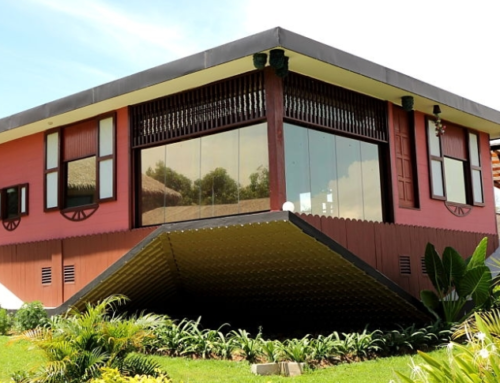It’s a sadly ironic twist of fate that a safe and cuddly name like Mr Fluffy is now associated with the horrific state of affairs that more than a thousand Canberra homeowners currently find themselves in.
The home asbestos insulation nightmare started back in the 1960’s when the dangers of asbestos weren’t fully realised, and raw, crushed asbestos was pumped into peoples’ homes as a cheap form of insulation. Mr Fluffy was one of the companies doing this in the ACT, and the homes they insulated are now sentenced to be demolished. The reason for this is that despite there being a government cleanup nearly two decades ago, in which the asbestos insulation in homes was largely removed, it has since been discovered that some of the deadly fibres still remain.
But is it an overreaction to completely demolish the homes that people have been living in for up to forty years, and are those being forced to leave being given adequate compensation for their losses? We’ve taken a step back to examine the arguments on both sides, in an attempt to discover the truth about the Mr Fluffy Canberra Asbestos Nightmare.
Asbestos health risks
For those who may have heard of asbestos but aren’t really sure why it’s such a big deal, here is an overview of the properties and characteristics of this naturally occurring mineral fibre.
There are two groups of asbestos:
After its discovery, asbestos proved to be a versatile fibre that could be used in a variety of applications. Its chemical inertness, tensile strength, insulation properties, flexibility and affordability all combined to make it a useful item for over 3,000 purposes worldwide.
Unfortunately for Australians, we were one of the highest users per capita of asbestos products, and an estimated one third of all Australian-built homes are said to contain asbestos products, and if your house was built before 1985 then the odds are very high asbestos will have been used.
Asbestos fibres are dangerous to humans when they are inhaled, and can caused the following health issues:
Mr Fluffy
Mr Fluffy was a home insulation company in Canberra that was first started in 1968, and then ceased operating in 1979. This was when asbestos use was at its highest peak, and so it was used by Mr Fluffy as their primary insulation material.
After the cleanup in the 1980s of the affected Canberra homes, it was assumed the problem had been fixed. However, surveys conducted in 2014 found that microscopic asbestos fibres had been detected inside the living areas of more than 80 Mr Fluffy homes, of the more than 1000 homes that were insulated by the Mr Fluffy company.
It is believed that over the years, the asbestos remnants from the blow-in insulation have made their way down through small cracks in ceilings, cornices, and built-in robes via poorly fitted timbers as well as poorly sealed wall and ceiling sheets. These particles are then redistributed through living areas via the air conditioning and central heating ducts.
The proposed solution
The ACT government’s Asbestos Task Force has implemented a Buyback Program where the government purchases My Fluffy houses from the owners at a price decided on after two separate property valuations.
The cost of the proposed buyback of Mr Fluffy homes will be borne entirely by the ACT government, because the Federal Government has denied any responsibility on their part for compensating those affected.
As a concession, however, they will lend the ACT government $1 billion at a special Commonwealth interest rate of just 0.6%, which will save the ACT government around $32 million in interest over 10 years. The $1 billion is to solely be used to buy the more than 1,000 Mr Fluffy homes from their owners at market value, and then demolish them and clean the land of any traces of asbestos.
Additionally, a Relocation Assistance Grant was created in 2014 for those forced to leave their homes due to the presence of asbestos. The full details of this grant can be found here
The ACT government plans to recoup some of the money by rezoning the vacant land for multi-unit occupancy, which means the blocks will fetch much higher prices than their current zoning attracts and that the land value will be worth much more than the price paid by the government to the original homeowner.
An alternate way forward
If the homeowner of an affected home chooses not to sell their property to the government, then they are responsible for the cost of asbestos removal, management and safe disposal, the demolition of their old home, and the re-building of a new home. While this may sound like an expensive proposition at the outset, ultimately you will be in a better position in terms of the market value of your new home.
The first step that any Canberra resident should do if they are not sure they want to sell their land as part of the buyback scheme is to contact AAC Environmental, Canberra’s premier asbestos and environmental consultants. They have more than 45 years experience with asbestos, and use government-approved methodology to provide homeowners with an ‘Asbestos Removal Control Plan’ (ARCP).
The next step is to contact an experienced demolition company that is qualified and licensed to demolish your home, such as Irwin & Hartshorn Pty Ltd.
It’s also worth contacting your water and gas provider to see if there is any way you can halt your service costs during the period of demolition and re-building. For example, ACTEW Water amd ActewAGL recently announced new support packages, dedicated contacts and fee waivers for those with Mr Fluffy homes. The full details of this can be found here.
The repercussions for homeowners
The government has only given Mr Fluffy home owners a short time to sign up to the buyback scheme and, while they will be paid market value for their homes, it seems they will also incur various costs and penalties as a result of selling up.
If they buy a new home somewhere else, they will have to pay legal fees and stamp duty, for which they will not be compensated by the government.
And while they have been given the option to buy their old land back and rebuild on it, it will be sold at the market value at that future time and not the market value of when they sold. Given the proposed rezoning, this will result in a price hike that is outside the affordability range of many of the current homeowners.
Even those who could afford it would have to wait some time to return to their land, as the buyback and subsequent demolition will be rolled out suburb by suburb, possibly over several years.
Furthermore, the block they are eventually able to purchase would probably not be as large as their original block due to the planned subdivisions to accommodate units.
Other less obvious but equally onerous issues Mr Fluffy homeowners could face include:
And there are also repercussions that go beyond the homeowners themselves. The demolition will not only override national trust laws and tree protection legislation, but in the future anyone who owns a house built before 1990 will need to have a full assessment of their property before they can sell it or before any maintenance or renovations can be carried out.
Other opinions
Despite the obvious dangers of asbestos, it’s to be noted that two leading experts have commented on the government’s demolition plan, indicating that it might be something of an overreaction. Dr David Douglas and Emeritus Professor Bruce Armstrong are medical experts who were asked to assess the Mr Fluffy homes in the 1980s by the then Hawke government. Their recommendations led to the homes being ‘remediated’ (having the insulation removed), rather than anything more heavy-handed such as demolition.
Professor Armstrong told ABC News recently that he was unaware of anyone from the remediated Mr Fluffy houses having suffered any asbestos-related disease, and Doctor Douglas said the government should conduct a cost-benefit analysis of the risks before considering anything as extreme as demolition.
An asbestos health study has since been announced that will track the health status of Mr Fluffy home residents in order to determine if any asbestos-related diseases are present.
So what options do home owners really have?
Admittedly the government has stepped in to try and resolve some of these problems, but they still serve to highlight the kind of nightmare scenario Mr Fluffy homeowners have been experiencing since the buyback scheme first raised its head.
The government has conceded that they may make some allowances for those who strongly object to the buyback or those who are elderly, possibly allowing them to remain in their homes until the very last stages of the scheme. But the official line is that long-term habitation is neither practical nor safe, so it seems only a matter of time before the last Mr Fluffy home disappears.
Theodora Ahila, the Head of Maurice Blackburn’s asbestos practice, summed it up best when she spoke recently to The Canberra Times. She asked whether Mr Fluffy homeowners would be assisted in finding and buying new homes and whether they would be compensated for the disruption to jobs and schools that moving would entail. And how would the government stop the real estate market from becoming distorted due to unscrupulous vendors inflating prices?
At the end of the day, there seem to be more questions than answers and more costs than benefits for those caught up in the Mr Fluffy Asbestos Nightmare. Before making any decisions about your home, contact the asbestos removal, house demolition and home building experts in Canberra to get relevant price quotes, so that you can make an informed decision about what action to take next.





